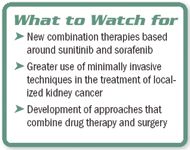Article
Two new drugs highlight advances in RCC treatment
Slow, steady, and encouraging are the most appropriate terms todescribe recent changes in the treatment of renal cell carcinoma.Breakthroughs are on the horizon, and two new drugs andevolutionary advances in surgical technique add up to a hopefulpicture.
Slow, steady, and encouraging are the most appropriate terms to describe recent changes in the treatment of renal cell carcinoma. Breakthroughs are on the horizon, and two new drugs and evolutionary advances in surgical technique add up to a hopeful picture.
The biggest news is the approval of sunitinib maleate (Sutent) and sorafenib (Nexavar) earlier this year for metastatic RCC. Both agents were fast-tracked by the FDA, said Robert C. Flanigan, MD, professor and chair of urology at Loyola University Stritch School of Medicine, Maywood, IL.

Durability of response remains a significant question with both of the new drugs, he added. Between 5% and 7% of patients treated with IL-2 have a complete response lasting a decade or more, long enough to start thinking in terms of "cure." Follow-up with sunitinib and sorafenib is short, but about 25% of patients have also shown stable disease in trials to date.

Both sunitinib and sorafenib offer multiple mechanisms of activity, including inhibition of vascular endothelial growth factor (VEGF) and platelet-derived growth factor. Potential combinations include the two drugs together, as well as individual combinations with bevacizumab (Avastin), a VEGF inhibitor approved to treat metastatic colorectal cancer, interferon, IL-2, and other cytokines.
Surgical advances
Nearly all of the patients in whom sunitinib and sorafenib have been studied had undergone radical nephrectomy before the drug trial, Dr. Flanigan noted. Published data from a Southwest Oncology Group trial suggested that surgery will continue to play an important role in the management of metastatic disease.
"Even with the advent of these new drugs, debulking the tumor load by removing the primary [tumor] will probably continue to play a major role in treatment," he said.
Surgery will also continue to play a major role in the treatment of nonmetastatic disease, but look for a growing emphasis on minimally invasive procedures. Within the last few years, minimally invasive procedures have become the standard of care for organ-confined disease. The most common modalities are laparoscopic partial nephrectomy, cryoablation, and radiofrequency ablation.
"As more information about these modalities is available, they are being used more widely," Dr. Flanigan said. "Where they fit into the spectrum of treatment from laparoscopic total nephrectomy to open approaches for smaller kidney tumors is still up in the air, but things are certainly moving to a minimally invasive approach."
Looking farther into the future, Dr. Flanigan expects to see the development of approaches that combine drugs and surgery. Drugs with a significant partial response rate, such as sunitinib and sorafenib, may be used to reduce the bulk of the primary tumor, thus reducing the scope of surgery needed to remove the tumor. At worst, Dr. Flanigan said, such drugs may be used to stabilize disease before surgical intervention.





